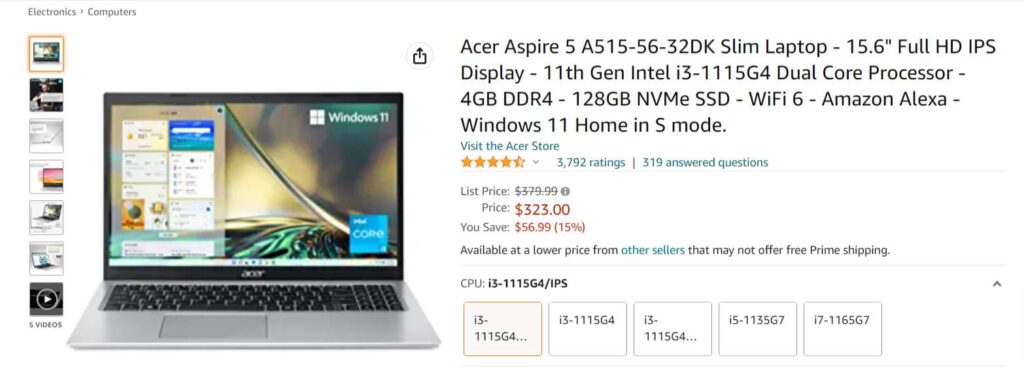Did you know that 70% of shoppers decide to click on a product just by reading its title? That’s why product title optimization is one of the most important things to focus on in your eCommerce strategy.
Product titles are often the first thing customers see when they search for something online. A strong product title can grab their attention, give the right information, and encourage them to click.
Product title optimization helps you create titles that are clear and appealing enough to boost clicks and sales to your website.
In this article, we’ll explore eight simple tips to write engaging and effective product titles for your eCommerce site. We’ll also look at product title examples from different industries and give examples for each tip to make things easier to follow.
Why Product Title Optimization Matters for Ecommerce Success
Product title optimization plays a very important role in capturing the attention of a user. A thoughtful and well-written product title helps your product stand out in a crowded marketplace, especially when customers are quickly scrolling through search results or online store listings.
Studies show that users skim through product titles in SERP or Listing Pages for just a few seconds before deciding to click.
If your title isn’t engaging enough to catch their eye or if it doesn’t clearly explain what the product is, they’ll move on without a second thought. An engaging product title improves click-through rates, and better clicks often lead to higher conversions.
This product title optimization also supports search engine performance. When your product titles are relevant and clear, there is a high chance that they will appear in the right searches.
This helps potential buyers find what they need faster and increases your chances of showing up in both organic search results and paid ads.
Long story short, engaging titles boost visibility, build interest, and influence buying decisions. Without effective product title optimization, even the best products can get overlooked.
How to Write Product Titles for Better Optimization
Here are the top 8 product title optimization tips based on our ‘Product title best practices’ checklist to help you attract more customers and improve search visibility:
1. Keep it Short and Informative
When writing eCommerce product titles, keeping them short and informative is essential. Short titles are more likely to be shared, clicked on, and remembered. Additionally, titles should be informative and clearly describe the product.
But remember, you should avoid using overly long titles. Instead, focus on making the title concise yet conveying the necessary information. This helps to make the title more engaging and easier to read and understand.
Keeping it short and informative helps customers find the product they’re looking for. It also helps search engine algorithms understand the title’s content. A good product title should include the product name and any key features, benefits, or distinctions that make the product unique.
Additionally, you can include keywords that shoppers are likely to search for. This will improve the visibility of the product in search engine results.
Example:
Before – Stylish and Comfortable Summer Sandals for Women with Cushioned Sole and Adjustable Straps
After – Women’s Summer Sandals with Cushioned Sole and Adjustable Straps
2. Write for Your Target Audience
When writing product titles for an eCommerce site, it is important to consider your target audience and write in a way that resonates with them. This means you should consider the type of language they use and the style of writing they prefer.

Consider the demographics of your target audience and tailor your product titles to fit their needs. Additionally, focus on the product’s benefits and how it can solve their problems rather than simply listing features.
By tailoring your product titles to your target audience, you can create more engaging titles that are more likely to drive sales.
Additionally, writing for a specific audience can help you identify more effective keywords and search terms to include in your product titles. This will help search engines and shoppers better understand your product and make it easier for them to find.
You can know about your target audience and customer behavior through eCommerce analytics. It will help you optimize your marketing strategies and improve customer experience.
Example:
Before – Smartwatch with Multiple Features Suitable for Everyone
After – Fitness Smartwatch for Runners with Heart Rate and Step Tracker
3. Include Keywords in The Title
Inserting keywords into product titles is a great way to make them more engaging. Using keywords relevant to the product can ensure that customers looking for specific items more easily find your titles. You can achieve this through product title optimization.
This is possible, as relevant search terms and phrases in the product title are commonly used by potential customers when searching for similar products.
Including keywords in the title can also help to convey the product’s features and benefits. This makes the title more engaging and eye-catching.
Additionally, keywords related to the product can make the title more interesting and attractive to potential customers. This increases the likelihood that they will click through and purchase the item.
Example:
Before – Beautiful Handmade Mug
After – Handmade Ceramic Coffee Mug for Home and Office Use
4. Include Main Product Attributes
Including main product attributes in product titles is an important tip when writing engaging product titles for an eCommerce site. This means incorporating the key features or characteristics of the product that are most likely to be of interest to customers.
Here are some examples of product attributes that you can include:
- Brand Name
- Material
- Color
- Size
- Certification
- Quantity
Including main product attributes in your product titles is a great way to help customers quickly identify the product they are looking for. By including only the most important attributes in the title, customers can determine whether the product is what they need without reading the full description.
If you’re selling a laptop, include the brand, size, processor type, and other key features in the product title. This will help customers identify the product quickly and accurately and make it easier for search engines to index the title.
This can improve the customer experience and encourage repeat purchases. Including product attributes can help your titles appear higher in search engine results. Many search engines prioritize titles when determining what to show users.
Example:

Before – Acer Laptop for Everyday Use
After – Acer Aspire 5 A515-56-32DK Slim Laptop 15.6 Inch Full HD IPS Display 11th Gen Intel i3 4GB RAM 128GB SSD WiFi 6 Windows 11
5. Arrange Words in The Product Title
Arranging words in the product title is essential to writing an engaging product title for an eCommerce site. When choosing words for the title, it is important to consider the order in which they should be placed. This will accurately and concisely describe the product.
The words in the title should be organized in a meaningful order. It should convey a clear and concise message about the product.
For example, an eCommerce store selling sports shoes might arrange the words in a product as “Men’s Running Shoes – Athletic Footwear”. This arrangement makes the product title easy to understand. It increases potential customers’ chances of getting noticed.
The order of words should also draw attention to the product and make it more likely to be noticed by customers. Additionally, the arrangement of words should help create a title that is easily searchable and understood by search engines.
Example:
Before – Footwear for Men Running
After – Men’s Running Shoes Lightweight and Breathable
6. Include USP
A product’s USP (Unique Selling Proposition) sets it apart from its competitors. Including the USP in product titles can help draw attention to the product, making it more attractive to potential customers.
It also helps to differentiate the product from similar products. It gives customers a clear understanding of what makes it unique. For example, if a product is made from organic materials, the title could include this as part of its USP.
The USP should clearly describe what makes the product unique, such as its benefits, features, or advantages over competing products.
Customers can quickly identify a product’s unique features by including the USP in product titles. This allows them to make an informed decision about whether to purchase it.
Example:

Before – Samsung Galaxy Smartphone with Android OS
After – Samsung Galaxy Z Fold 4 Cell Phone Factory Unlocked Android Smartphone 512GB Flex Mode Foldable Display S Pen Compatible Phantom Black
7. Keep it Distinctive
This means you should strive to create a product title that stands out from the competition. Unique, catchy product titles can draw attention to the item and make it more memorable.
It is important to create memorable titles that will attract customers. This can be done using creative language, incorporating keywords, and using catchy phrases.
Try to use words and phrases not commonly used in the industry and stand out to the consumer. This will help capture potential buyers’ attention and create a memorable impression. You should use descriptive language and avoid generic phrases or words to achieve this.
Also, you should use keywords to create search engine-friendly titles and help increase visibility.
Additionally, titles should include the product name, brand, and other relevant details. By making titles distinctive, customers will remember them and be more likely to purchase the product.
Example:
Before – Premium Notebook for Writing
After – Luxury Leather Writing Notebook with Gold-Trimmed Pages
8. Avoid Clickbait
Avoiding clickbait is crucial for maintaining audience trust and building a credible online presence. Clickbait uses sensational or misleading titles to draw attention, but often leads to disappointment, harming your reputation. Instead, create compelling yet honest headlines that accurately represent your content.
Focus on providing value—deliver content that informs, entertains, or solves problems. Use clear and concise language to outline what readers can expect. Ensure your content aligns with their needs and interests.
Avoid exaggeration, overpromising, or manipulating emotions. Instead, use facts, benefits, or thought-provoking questions to engage your audience. Consistently meeting expectations fosters loyalty, enhances your brand’s credibility, and improves search engine rankings.
Remember, sustainable success online comes from authentic engagement, not short-lived clicks. Trustworthy content creates meaningful connections that drive long-term growth.
Example:
Before – This Cream Will Erase All Wrinkles Instantly
After – Anti-Aging Face Cream with Retinol and Vitamin C for Fine Lines
Industry-Wise Product Title Examples
According to a 2023 study by Baymard Institute, using product titles tailored to specific industries can improve click-through rates by up to 30 percent.
So, in this section, we’ll show you our product title optimization best practices across different industries. By looking at the examples in the following table, you’ll understand how to write titles that match what shoppers are searching for and will help your products stand out in the competition.
| Industry | Product Title Template | Example |
| Fashion | [Gender] [Fit] [Material] [Clothing Type] with [Detail] | Men’s Slim Fit Cotton Shirt with Full Sleeves and Spread Collar |
| Electronics | [Brand] [Product Type] with [Key Feature] and [Benefit] | Sony WH-1000XM5 Wireless Headphones with Noise Cancelling and 30h Battery |
| Beauty & Skincare | [Ingredient] [Product Type] with [Function or Skin Benefit] | Vitamin C Face Serum with Hyaluronic Acid for Brightening and Anti-Aging |
| Home Appliances | [Capacity] [Appliance Type] with [Technology] and [Performance Spec] | 7 Kg Front Load Washing Machine with Inverter Motor and 1200 RPM Spin Speed |
| Fitness Equipment | [Type] for [Usage] with [Key Feature] and [Accessory] | Adjustable Dumbbell Set for Home Gym with Non-Slip Grip and Storage Rack |
Conclusion
In conclusion, writing engaging product titles for an eCommerce site is an important part of creating a successful online store.
It’s essential to craft creative, catchy titles that accurately describe the product and its features. This way, you can ensure that customers find and purchase your products through effective product title optimization.
Keep titles concise and to the point. Use search engine optimization techniques to ensure your titles are relevant and searchable.
Additionally, consider including keywords, numbers, and other elements. It will draw the attention of potential customers.
With practice and experimentation, you can create appealing product titles. To stand out from the competition, optimize your eCommerce store to increase conversions, sales, and revenue. This can be done by improving your CRO, SEO, and UI/UX.
If you enjoyed reading this article, you should consider going through the following.
- 8 Critical Steps to Build a B2B Sales Funnel.
- How to Build a Winning B2B SEO Strategy for Your Business.
- How to Optimize the eCommerce Conversion Funnel.
Want to improve your product titles and boost your store’s performance? Schedule a free eCommerce audit with HumCommerce today!









